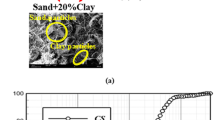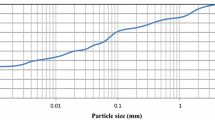Abstract
Different doses of carbide slag and metakaolin are used to solidify/stabilize copper-contaminated soil in accordance with its degree of contamination. This paper presents some experimental findings on the physical and chemical properties of the treated soil, including unconfined compressive strength, stress–strain state and pH, explained by series chemical and mineralogical reactions in the solidified/stabilized soil. Results showed that the unconfined compressive strength decreases and the failure strain increases with the copper ion concentration in the soil increasing. Additionally, the failure mode of the soil gradually changed from fragile failure to plastic failure. Increasing the amount of carbide slag favored improvements in unconfined compressive strength, yet decreased the failure strain. Furthermore, the pH of the soil decreased from 8.22 to 4.36 with the initial concentration of heavy metal in the contaminated soil increasing. High concentrations of Cu2+ react with OH− in pore solutions to form complexes like [Cu(OH)4]2– to decrease alkalinity in the soil. Additionally, under certain conditions, the reaction of carboxyl (–OH) and hydrated groups (–OH2) with Cu2+ release H+, which will also reduce the pH value in the soil. However, when the carbide slag content increased from 5 to 15%, the pH increased significantly, up to 10.5, demonstrating the beneficial effect of the industrial waste carbide slag in solidifying/stabilizing the copper-contaminated soil.
















Similar content being viewed by others
References
Alahrache S, Winnefeld F, Champenois JB, Hesselbarth F, Lothenbach B (2016) Chemical activation of hybrid binders based on siliceous fly ash and Portland cement. Cem Concr Compos 66:10–23
ASTM (2012) Standard test methods for laboratory compaction characteristics of soil using standard effort. ASTM D698–12. ASTM, West Conshohocken
Chang JH, Dong CD, Huang SH, Shen SY (2020) The study on lead desorption from the real-field contaminated soil by circulation-enhanced electrokinetics (CEEK) with EDTA. J Hazard Mater 383:121194
Chen L, Liu SY, Du YJ, Jin F (2010) Unconfined compressive strength properties of cement solidified/stabilized lead-contaminated soils. Chin J Geotech Eng 32(12):1898–1903 (in Chinese)
Chen YG, He W, Ye M, Sui WH, Xiao MM (2013) Effect of shaking time, ionic strength, temperature and pH value on desorption of Cr (III) adsorbed onto GMZ bentonite. Trans Nonferrous Metals Soc China 23(11):3482–3489
Cheng F, Wang XH, Mo SX (2014) Effects of mass ratio of heavy metal on geotechnical properties of contaminated soil. Min Metall Eng 34(5):14–18 (in Chinese)
Chen M, She Y, Liu Y (2018) Sludge curing agent comprises calcium carbide slag and rice husk ash as two kinds of wastes. CN109081540-A, Huaiyin Technology Inst (HUIA-C) (in Chinese).
Contessi S, Calgaro L, Dalconi MC, Bonetto A, Bellotto MP, Ferrari G, Marcomini A, Artioli G (2019) Stabilization of lead contaminated soil with traditional and alternative binders. J Hazard Mater 382:120990
Du YJ, Jiang NJ, Liu SY, Jin F, Singh DN, Puppala AJ (2014) Engineering properties and microstructural characteristics of cement stabilized zinc-contaminated kaolin. Can Geotech J 51:289–302
El-Sherbiny S, El-Sheikh SM, Barhoum A (2015) Preparation and modification of nano calcium carbonate filler from waste marble dust and commercial limestone for papermaking wet end application. Powder Technol 279:290–300
Fan XH, Xu HQ, Wang SW (2019) Geotechnical properties of sewage sludge solidified with Sulphoaluminate cement. E3S Web of Conf 81: 01015
GB/T (2009) Disposal of sludge from municipal wastewater treatment plant-Quality of sludge for co-landfilling. GB/T 23485–2009, BJ.
Guo Q, Wei ML, Xue HC, Gao CH, Du GY (2019) Strength and pore structure development of high-plasticity clay treated with MK-blended cement. Adv Civ Eng 2019:1–8
Hills CD, Pollard SJT (1997) The influence of interference effects on the mechanical, microstructural and fixation characteristics of cement-solidified hazardous waste forms. J Haz Mater 52(2–3):171–191
ISO (2012).Soil quality—effects of pollutants on earthworms. ISO 11268–2012, Biological characterization
Jiang NJ, Du YJ, Liu SY, Wei ML (2016) Multi-scale laboratory evaluation of the physical, mechanical, and microstructural properties of soft highway subgrade soil stabilized with calcium carbide residue. Can Geotech J 52:1–11
JTG (2007) Test Methods of soils for highway engineering. JTG E40–2007, Ministry of Transport of the People's Republic of China (MOT), BJ.
Lei M, Pan YQ, Chen CY, Du HH, Tie BQ, Yan XP, Huang RZ (2019) Application of economic plant for remediation of cadmium contaminated soils: three mulberry (Moms alba L.) varieties cultivated in two polluted fields. Chemosphere 236:1124379
Li M, Liu M, Yang YY, Li ZY, Guo XY (2015) Mechanical properties of oil well cement stone reinforced with hybrid fiber of calcium carbonate whisker and carbon fiber. Sci Total Environ 42(1):104–111
Liu LW, Li W, Song WP, Guo MX (2018) Remediation techniques for heavy metal-contaminated soils: Principles and applicability. Constr Build Mater 633:206–219
Liu YY, Chang CW, Namdar A, She YX, Lin CH, Yuan X, Yang Q (2019) Stabilization of expansive soil using cementing material from rice husk ash and calcium carbide residue. Constr Build Mater 221:1–11
Ma XL, Du PY, Zhang ZJ, Dong CJ (2017) Progress on Resource. Utilizat Carbide Slag 46(19):71–72 (in Chinese)
Ministry of Environmental Protection, Ministry of Land and Resources (2017) Guide to Remediation Technology of Contaminated Site-solidification/stabilization Technology (Trial), Beijing
Peng L, Zhang W, Wu D (2018) Research on restoring heavy metal polluted urban soil by solidification/stabilization. Environ Sustain Dev 43(5):142–144
Rogers RD, Knights JJ, Cheeseman CR, Wolfram JH, Idachaba M, Nyavor K, Egiebor NO (2003) Development of test methods for assessing microbial influenced degradation of cement-solidified radioactive and industrial waste. Cem Concr Res 33(12):2069–2076
Sun Z, Chen SY, Ma SW, Xiang WG, Song QB (2016) Simulation of the calcium looping process (CLP) for hydrogen, carbon monoxide and acetylene poly-generation with CO2 capture and COS reduction. Appl Energy 169:642–651
Tan WF, Wang YC, Ding L, Lv JW, Fang Q (2019) Effects of phosphorus modified bio-char on metals in uranium-containing soil. Water Air Soil Pollut 230:35
Thriveni T, Ahn JW, Ramakrishna C, Ahn YJ, Han C (2016) Synthesis of nano precipitated calcium carbonate by using a carbonation process through a closed loop reactor. J Korean Phys Soc 68(1):131–137
Wang F, Wang HL, Al-Tabbaa A (2015) Time-dependent performance of soil mix technology stabilized/solidified contaminated site soils. J Hazard Mater 286:503–508
Wang M, Li SS, Li XY, Zhao ZQ, Chen SB (2018a) An overview of current status of copper pollution in soil and remediation efforts in China. Earth Sci Front 25(5):305–313 (in Chinese)
Wang D, Zentar R, Abriak NE (2018b) Durability and swelling of solidified/stabilized dredged marine soils with class-f fly ash, cement, and lime. J Mater Civ Eng 30(3):04018013
Wu ZL, Deng YF, Liu SY, Liu QW, Chen YG, Zha FS (2016) Strength and micro-structure evolution of compacted soils modified by admixtures of cement and metakaolin. Appl Clay Sci 127:44–51
Xia WY (2018) Immobilization mechanisms and field evaluation of a new hydroxyapatite based binder for solidification and stabilization of heavy metal contaminated site soil. Southeast UniversityNanjing
Xu L (2012) Research on remediation and long-term stability of solidified/stabilized heavy metal contaminated soil. Hefei University of Technology, Hefei
Yuan ZM (2018) Study on the immobilization remediation of heavy metal pollution in the farmland soil of Bijie City. University of Science and Technology, Beijing
Zang Y (2016) Statistics and management of energy consumption in cement manufacturing industry. Premiere 88:208
Zhang XN, Ding XQ, Wan YL, Xiong D, Zhu ZL (2012) Formation mechanism and distribution of clay minerals of deeply tight siliciclastic reservoirs. J Southw Pet Univ (Sci Technol Ed) 34(3):174–182 (in Chinese)
Zhang Y, Ye WM, Chen B, Chen YG, Ye B (2016) Desiccation of NaCl-contaminated soil of earthen heritages in the Site of Yar City, northwest China. Appl Clay Sci 124:1–10
Acknowledgements
This study received financial support from the National Natural Science Foundation of China (Grants No. 41772279 and No. 41977232). This work was also supported by the Opening Project of Tunnel and Underground Engineering Research Center of Jiangsu Province (TERC).
Author information
Authors and Affiliations
Corresponding authors
Additional information
Publisher's Note
Springer Nature remains neutral with regard to jurisdictional claims in published maps and institutional affiliations.
Rights and permissions
About this article
Cite this article
Sun, YJ., Ma, J., Chen, YG. et al. Mechanical behavior of copper-contaminated soil solidified/stabilized with carbide slag and metakaolin. Environ Earth Sci 79, 423 (2020). https://doi.org/10.1007/s12665-020-09172-3
Received:
Accepted:
Published:
DOI: https://doi.org/10.1007/s12665-020-09172-3




